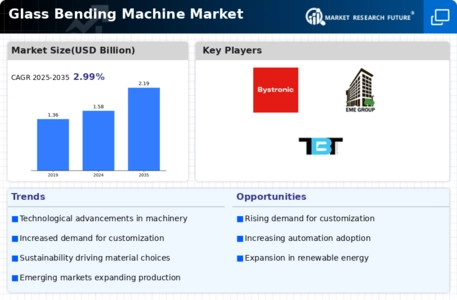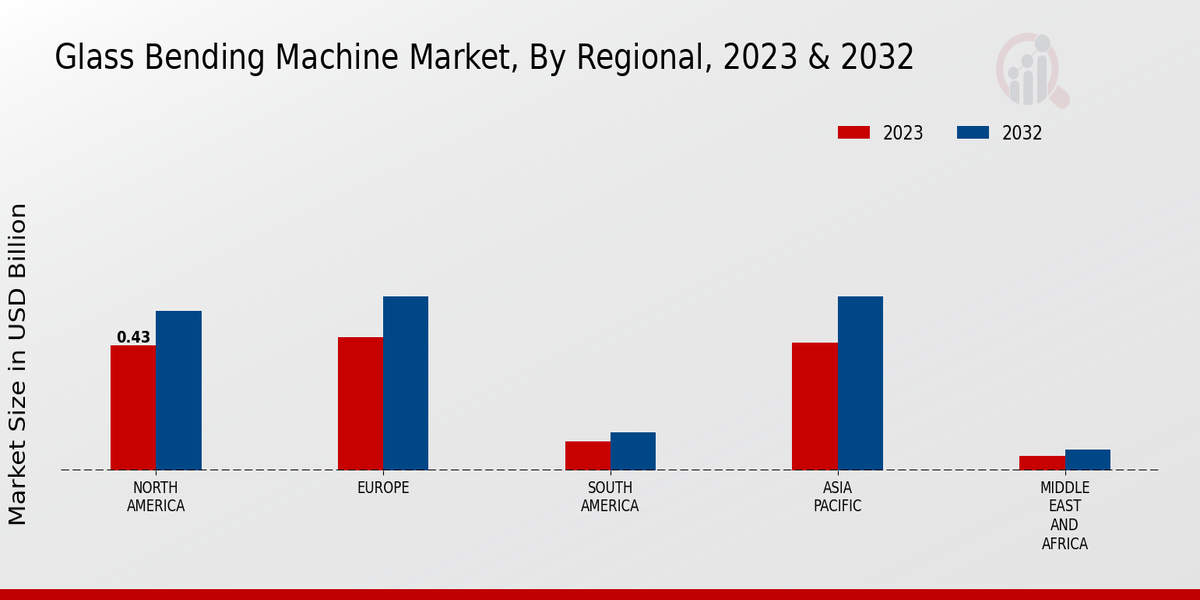Growth in the Construction Sector
The construction sector's expansion significantly influences the Global Glass Bending Machine Market Industry. With urbanization and infrastructure development on the rise, there is an increasing requirement for glass products in buildings, facades, and interiors. This trend is particularly pronounced in emerging economies, where rapid urban development is underway. The demand for aesthetically pleasing and functional glass solutions drives the need for advanced bending machines capable of producing intricate designs. As the market evolves, it is projected to reach 2.19 USD Billion by 2035, underscoring the construction sector's pivotal role in the growth of the Global Glass Bending Machine Market Industry.
Emerging Markets and Globalization
Emerging markets and globalization significantly impact the Global Glass Bending Machine Market Industry. As economies in Asia-Pacific, Latin America, and Africa continue to grow, there is an increasing demand for glass products in various applications, including automotive, architecture, and interior design. Globalization facilitates the exchange of technology and expertise, enabling manufacturers in these regions to adopt advanced glass bending technologies. This trend not only enhances local production capabilities but also contributes to the overall growth of the market. As a result, the Global Glass Bending Machine Market Industry is poised for expansion, driven by the rising demand from emerging markets.
Rising Demand for Customized Glass Products
The Global Glass Bending Machine Market Industry experiences a notable surge in demand for customized glass products, driven by architectural innovations and consumer preferences. As industries increasingly seek unique designs, the need for advanced glass bending technologies becomes paramount. This trend is particularly evident in sectors such as automotive and construction, where bespoke glass solutions are essential. The market is projected to reach 1.58 USD Billion in 2024, reflecting a growing inclination towards personalized glass applications. This shift not only enhances aesthetic appeal but also promotes functional advantages, thereby propelling the growth of the Global Glass Bending Machine Market Industry.
Technological Advancements in Glass Processing
Technological advancements play a crucial role in shaping the Global Glass Bending Machine Market Industry. Innovations such as automated bending processes and precision control systems enhance production efficiency and product quality. These advancements enable manufacturers to meet the increasing demands for complex glass shapes and sizes, which are becoming more prevalent in modern architecture and design. As a result, the market is expected to witness a compound annual growth rate of 3.03% from 2025 to 2035. This growth is indicative of the industry's adaptability to technological changes, ensuring that the Global Glass Bending Machine Market Industry remains competitive and responsive to evolving market needs.
Environmental Regulations and Sustainability Initiatives
Environmental regulations and sustainability initiatives are becoming increasingly relevant in the Global Glass Bending Machine Market Industry. As governments worldwide implement stricter regulations regarding energy efficiency and waste reduction, manufacturers are compelled to adopt eco-friendly practices. This includes investing in energy-efficient bending machines that minimize resource consumption and reduce emissions. The shift towards sustainable production methods not only aligns with regulatory requirements but also appeals to environmentally conscious consumers. Consequently, this trend is likely to drive innovation and investment in the Global Glass Bending Machine Market Industry, fostering a more sustainable future for glass processing.















Leave a Comment